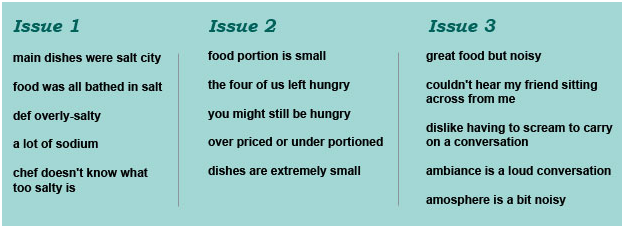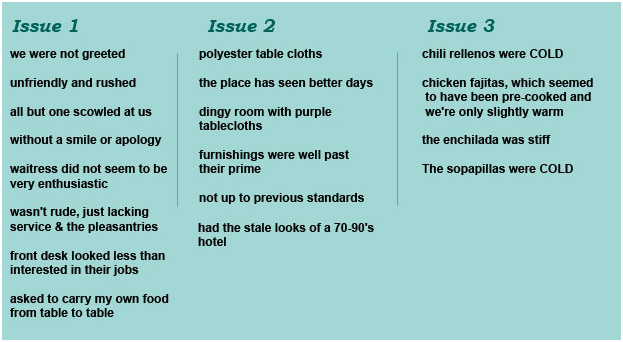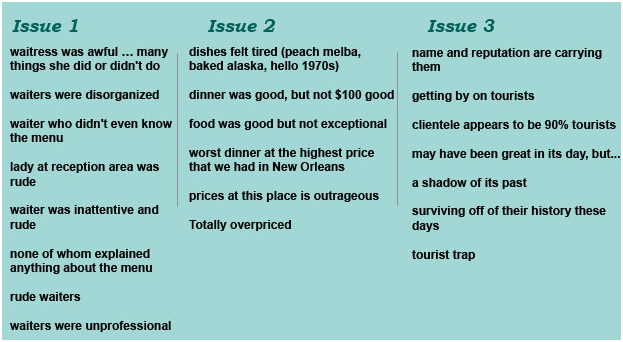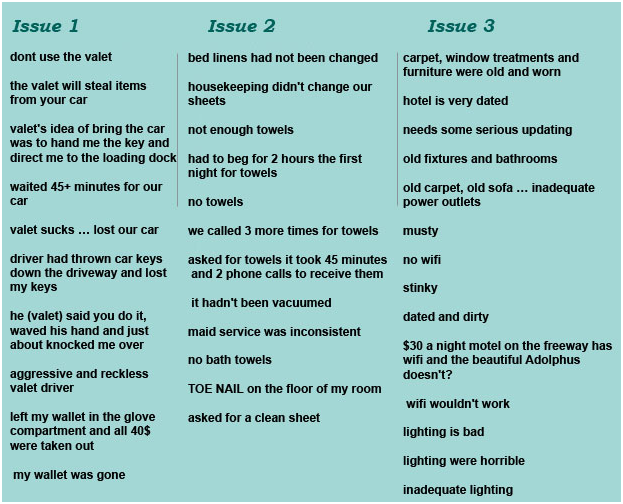🤓 The 2026 Local Search Ranking Factors are here!! Check out the report!
🤓 The 2026 Local Search Ranking Factors are here!! Check out the report!

I confess, I’m a restaurant review addict. Weird as this may sound, I fritter away all kinds of free time reading the reviews of famous restaurants which I’ll probably never have the chance to visit. As a form of recreational reading material, reviews offer great drama, high hopes, crushing disappointments and glimpses of life that tell a story of big wins and big losses. In this post, I’ll show you how to mine reviews, organize data and turn those losses into wins.
This process can work for any adequately-reviewed business, and Darren Shaw has kindly shared with me his master list of the top 10 most-reviewed industries. These numbers are the results of his analysis of 110 keywords in 294 cities, paginated through 10 pages (100 results per search term). That’s review data for 110 x 294 x 100 – or a total of 3,234,000 – businesses!
Other runners-up that are abundantly reviewed? Catering, computer stores, cell phone repair, shopping centers, IT services, bed & breakfasts, air conditioning, apartment rentals and grocery stores.
We’re going to scrutinize the reviews of 3 well-known American eateries, surface their most-cited problems and offer solutions. This is a process you can be used for almost any business that has earned a substantial number of reviews.
| 1) First, go to the major review sites for your clients and make a simple list of all negative sentiments from the past 3 years. Want to automate this step for a faster turnaround? Use a service like Review Trackers or Free Review Monitoring, pull the data into a spreadsheet and then use search and replace to isolate and count the incidence of specific sentiment. |
| 2) Circle any negative sentiment that appeared 3 or more times in the last 3 years. |
| 3) Discard any that appeared less than 3 times, unless the review in question makes an accusation of a hazardous or illegal situation. You might want to keep your discard list on file for your client, in case a less-cited issue is an emerging one instead of an isolated one. |
| 4) Categorize complaints by type and make a final list for the client in an easy-to-read format. |
| 5) Summarize your findings and recommend solutions. |
Let’s take a look at the final product.
Made instantly famous by its creative owner, TV chef Ming Tsai, Blue Dragon opened its doors in 2013 and offers Asian Fusion cuisine. Many reviews absolutely rave about the exciting food and fun atmosphere there, but here are the negative sentiments from the restaurant’s Google+ Local and Yelp reviews, categorized by complaint type:

Now, write a summary of your findings for the owner. For Blue Dragon, a summary might look something like this:
You have a 3.5 star average rating on Yelp and a 4.2 star average rating on Google. You have hundreds of positive reviews from customers who love your food and really enjoy the atmosphere of your restaurant, but three issues repeatedly surfaced in reviews from customers who weren’t satisfied with some aspects of their experience. These issues are: the high level of noise in the restaurant, the small size of the portions and an overuse of salt in various dishes. A few reviews also mention burnt food being served, but unless this continues to surface, the issue was likely isolated.
Finally, offer specific suggestions for addressing each issue that has been surfaced. Your suggestions might read like this:
We have three real-world suggestions for resolving these areas of customer dissatisfaction:
Once these 3 solutions have been investigated/implemented, please respond on pertinent reviews to let your customers know what you’ve done to address their problems they took time to report. Express gratitude for their suggestions and showcase your responsiveness.
It will be up to the business owner to determine whether he or she wishes to act on your suggestions. Interest, dedication to customer service and budget will all play a part in their ability to respond. Some issues (like menu changes) can certainly be implemented, but others (like construction projects) may not be as easy to accomplish. At the very least, the owner has now been made aware of specific problems that could be preventing first-time diners from becoming loyal patrons.
This New Mexican restaurant has history on its side, founded in 1965 and since featured in high-profile cookbooks and other publications. Despite its age, the restaurant has only earned 23 reviews on Google, so we’ll head right over to Yelp to make our categorized list:

Your restaurant has an enviable 4 star average rating on Yelp which speaks very highly of customers’ experiences there. However, three specific problems are being repeatedly cited in reviews: wait staff is not friendly enough, food sometimes comes to the table cold and the décor is showing some wear.
Once these issues have been resolved, be sure to respond on the appropriate reviews to let your customers know you listened, cared and took action and that you hope they’ll visit again to experience the changes for themselves.
The first two problems should be something any competent restaurant can solve. The third will depend on budget, but may really be worth the investment given that multiple reviews suggest that the place is beginning to look dated.
This venerable establishment, founded in 1840, has become a landmark on the map of New Orleans cuisine. Chances are, with a reputation and history like Antoine’s, the restaurant will survive almost any number of bad reviews, but if our job were to surface common complaints, here’s what we’d have to share from Google+ and Yelp:

Given the fact that Antoine’s is credited with creating and setting the historic standard of New Orleans cuisine, it hurts to see only a 3 star rating on Yelp and 3.7 stars on Google. Despite the many ecstatic reviews the establishment has received over the years, there seem to be three fundamental issues that need to be addressed: the current wait staff has not been trained up to the restaurant’s historic high standards, prices are often perceived as too high for the quality of food being served, and, there is a sense that Antoine’s is resting on its well-earned laurels by catering to tourists rather than winning local patron loyalty these days.
I’m a sentimentalist, and can also get into the idea of historic places with eccentric staff and unusual dining experiences … provided the food is astoundingly good. I think any agency tasked with marketing Antoine’s would quickly identify that there is a public perception that the place isn’t what it used to be, and the job at hand would be to attack that perception head on, making a superlative effort to correct cited issues with a deft hand. You’d have to dig deep to get to the heart of what’s going on here, and a place like this would deserve all of the creativity and care any agency could muster.
Let’s take a quick look at how this same process can work in another industry. For this, I’ve chosen a legendary hotel, founded in 1912 – the Adolphus. Guests are deeply impressed by the architecture and history of this landmark, but here are some problems being cited in both the Yelp and Google Reviews. *I had planned to look at TripAdvisor as well, this being a hotel, but my list had already gotten too long for easy reading. For the sake of convenience, I’m keeping this short:

For nearly a century, the Adolphus has offered a one-of-a-kind stay in the Lone Star State and many guests are completely thrilled with the history and architecture of the hotel. However, there are some critical issues – some of which would be considered illegal or hazardous – which are putting the business at grave risk. These issues relate to problems with: the valet staff, including accusations of theft, inadequately stocked and cleaned rooms, and outdated fixtures, including a dangerous situation with inadequate lighting.
It’s amazing how clear problems can become once you start organizing them. Your reviewers are doing more than half the work for you, by taking the time to list their complaints. All you have to do is bring these complaints into clear view and make your best suggestions for their resolution.
Because I’m focusing mainly on restaurants here, I only looked at Yelp and Google+ Local. A full review audit will take into account whichever platforms are most pertinent to a client’s industry.
Negative reviews tell a story that can be painful for local business owners to listen to, but by cutting down clients’ workload with summarized lists and specific suggestions, you are giving them the means to write a better future for their businesses. Whether your clients are auto mechanics, dentists or tech companies, negative reviews are a gift, enabling us to hear the disappointment in a customer’s voice and, if the complaint is oft-voiced, to make absolutely specific changes that are pre-guaranteed to solve problems.
Don’t forget the important step of encouraging your clients to make owner responses to negative reviews, once issues have been addressed internally. Often, you’ll want to help your clients craft these for best success. There will be considerable effort required to address complex problems and any business that makes those kinds of investments should view publicizing them as a reward at the end of the road. All in one owner response, a smart business owner can prove that he listens, cares, acts and runs the sort of business we’d all like to visit.


Whitespark provides powerful software and expert services to help businesses and agencies drive more leads through local search.
Founded in 2005 in Edmonton, Alberta, Canada, we initially offered web design and SEO services to local businesses. While we still work closely with many clients locally, we have successfully grown over the past 20 years to support over 100,000 enterprises, agencies, and small businesses globally with our cutting-edge software and services.